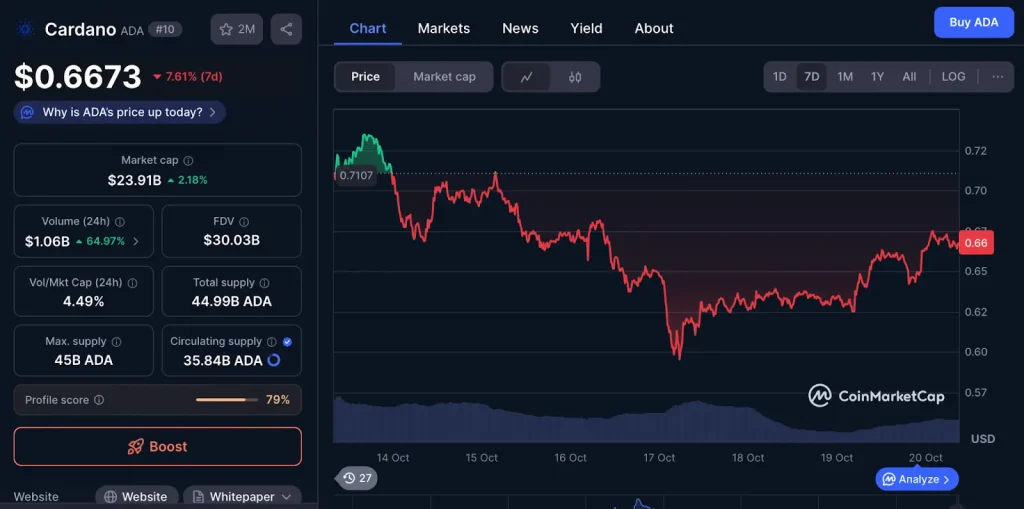Cardano Price Prediction Weakens as Digitap ($TAP) Captures the Global Banking Boom Narrative

The post Cardano Price Prediction Weakens as Digitap ($TAP) Captures the Global Banking Boom Narrative appeared first on Coinpedia Fintech News
The crypto market continues to face turbulence in 2025, and few tokens illustrate this better than Cardano. Trading around $0.66 and down nearly 8% on a weekly basis, ADA’s once unstoppable momentum has started to stall. Meanwhile, Digitap ($TAP) has emerged as one of the most compelling early stage fintech plays.
The narrative shift from speculative L1 blockchains to real world utility projects has become clearer over the last few months. Investors are searching for tokens that not only offer upside potential but also tangible usage in everyday finance. And that’s precisely why $TAP is beginning to dominate the conversation as one of the best altcoins to invest in.
Cardano’s Slowing Momentum Raises Questions
For years, Cardano was celebrated as one of the most promising blockchain ecosystems in the space. It boasted ambitious goals: scalability, low fees, and academic level research underpinning its development.
These strengths allowed it to build a loyal community and maintain a steady position in the top 10 cryptocurrencies by market cap.
However, its price action tells a different story. ADA’s performance in early 2025 has been lackluster, as market participants rotate out of projects that have yet to deliver mainstream adoption. Despite numerous upgrades, the network continues to lag behind faster, more flexible competitors. These factors likely contributed to its 8% weekly decline, down to $0.66.

This slowdown isn’t just a reflection of ADA’s fundamentals. It’s also about market preference. Investors increasingly want exposure to assets tied to digital payments, banking innovation, and practical integrations.
While ADA focuses on infrastructure, Digitap positions itself as a consumer facing fintech ecosystem that users can access today. It’s a live and functional ecosystem, not a promise about what will change in future.
Digitap’s First-Mover Advantage in Payments
Unlike many crypto startups still building their ecosystems, Digitap has already launched its app, available on both the App Store and Google Play Store. This real-world functionality sets it apart in a crowded presale market.
Digitap offers a working product, with the ability to integrate Web2 and Web3 financial services through one global app.
What makes this launch even more significant is its banking infrastructure narrative. Digitap positions itself as the world’s first omni bank, a hybrid between fintech and crypto that allows users to spend, save, and move funds instantly — all without traditional intermediaries. This appeals directly to users looking for flexible and borderless alternatives to legacy finance.
The platform’s staking APY of 124%, combined with its profit-burning model where 50% of platform profits are used to buy back and burn $TAP while rewarding stakers, creates strong tokenomics. This dynamic both reduces supply over time and rewards loyal holders, something Cardano has struggled to match on a retail incentive level.
At the time of writing, the presale has raised nearly $900K, with nearly 60 million $TAP tokens sold. The current token price sits at $0.0194 and will soon increase to $0.0268, a 38% jump to the next stage. This built-in upward price movement has become a major driver of FOMO, particularly among early stage investors.
Why the Market Narrative is Shifting
The current macroeconomic environment also plays a role in this narrative shift. 2025 has already seen increased institutional inflows into blockchain solutions that are tied to real world payments and banking utility. While older L1 chains like Cardano focus on infrastructure, the fintech narrative — pioneered by Digitap — is proving more attractive to investors.
Digitap taps directly into the 1.4 billion unbanked people worldwide, positioning itself as a potential on-ramp to the global economy. This is more than just a crypto play, but a financial inclusion story. Where ADA speaks primarily to developers, Digitap is building tools that can be used by anyone, anywhere, through a simple mobile interface.
Moreover, with rising volatility across major crypto assets, capital is rotating into presale assets that can outperform during the next bull leg. When the broader market is overpriced, whale investors are forced to migrate towards presales with tiered pricing models that are unaffected by broader market downturns.
How $TAP Leads a New Era of Fintech Tokens
The crypto landscape is evolving. Narratives built solely on infrastructure or speculative hype are losing ground to real utility, and Digitap stands at the center of that shift. Its zero KYC onboarding, privacy focus, strong tokenomics, and growing user base make it a standout in a crowded field, as one of the best altcoins to invest in.
Cardano may still have a place in the ecosystem, but investors searching for growth are increasingly looking at fintech-native tokens. As the presale nears the $1M mark, the market seems to agree. Digitap isn’t just another token launch — it represents a paradigm shift in how banking, payments, and crypto interact.
Discover how Digitap is unifying cash and crypto by checking out their project here:
- Presale: https://presale.digitap.app
- Website: https://digitap.app
- Social: https://linktr.ee/digitap.app
You May Also Like

What is Play-to-Earn Gaming? Unlocking New Possibilities

Michael Saylor Says Bitcoin May Go ‘Boring’ as Institutional Money Kills Volatility
